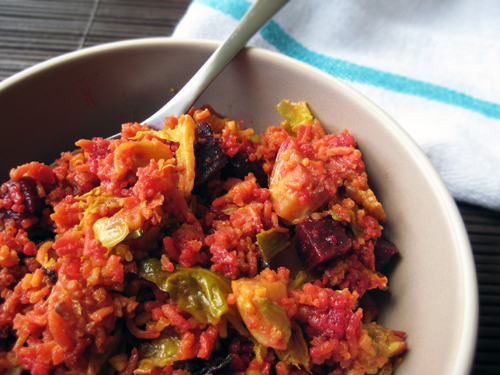Spring is appearing in SF in sneaky little bursts this year – a few days of gorgeous sunshine (Yay! How we’ve missed being outside!) followed by days of chilly rain (Wait, staying home is not so bad either!). But as far as I’m concerned, spring is already here and winter is just being a little lazy and clingy and not willing to let it go until next year. And let’s face it, we’ve all felt lazy and clingy at one time or another, so let’s give Mr. Winter a little break, shall we?
Besides, we don’t need good weather to deduce the arrival of spring, right? I have hard evidence in the forms of snap peas and green garlic in our veggie box from Two Small Farms. To be honest, because our CSA stops deliveries in the winter, Nathan and I are out of practice with our vegetable management skills. The other day, I opened the fridge and vegetables were practically tumbling off the shelves, threatening to crush a curious Toro who was just stopping by to check out the kibbles status of the fridge (yup, still negative).
We needed some spring cleaning (ha!) and needed it fast before next week’s veggie box threatens to jump into the fray. Whenever a vegetable purge is called for, we roll up our sleeves, chop up as much vegetables as is humanely possible, and throw them all into either a Thai curry or a vegetable biryani. You’ve probably guessed by now which recipe won this time.
We ended up with a not-very-traditional biryani because who puts beets in biryanis?! Well, we do, when we’re desperate. But guess what? They actually stained the rice into a pretty red color! Now, if only we made this closer to Chinese New Year, it would be very auspicious indeed.
For a more traditional and less red version, use vegetables more commonly used in biryanis such as carrots, peas, cauliflowers, etc. But almost any mix of firm vegetables would work here. I would avoid mushy ones like eggplants and super starchy ones like potatoes, because you don’t need to mix starch with starch. If you have some greens lying around, you can add them when the biryani is almost done cooking so they keep some of their green color.
vegetable oil
1 onion, chopped
2 garlic cloves, chopped
8 whole cloves
2-inch piece of cinnamon stick, broken in half
6 green cardamom (whole pods)
1 tsp turmeric
1 tsp garam masala
2 cups Basmati rice (soak in water while you’re gathering the other ingredients)
~2 cups of mixed vegetables, diced
2½ cups stock (vegetable or chicken)
salt
2 oz paneer (optional, as in it’s fine to leave it out if like me, you’re too lazy to go out and buy it)
⅓ cup golden raisins (optional, I’m not a big fan of raisins so we usually leave this out)
1 cup chopped mixed nuts (optional, we always leave this out in our house – some of you know why)
If you’re using paneer, cut it into cubes. Heat a bit of vegetable oil in a non-stick pan over medium-high heat and lightly pan-fry the paneer cubes until they’re browned on all sides. Set aside.
(Note: If you’re using any vegetables that require a long time to cook through like beets or hard winter squashes, you will want to cook these until they’re almost done before adding to the rice. We made the mistake of not pre-cooking our beets and so our biryani had slightly crunchy beets. So learn from our mistake and steam/boil/roast/saute your extra-sturdy vegetables beforehand.)
In a large pan with tall sides (I use a nonstick wok), heat a few tablespoons of vegetable oil over medium-high heat. Add onions and fry until soft. Add in garlic and all the spices (cloves, cinnamon, cardamom, tumeric, garam masala). Fry for another 2-3 minutes until your kitchen smells awesome.
Rinse the pre-soaked rice under cold water and drain well. Add to the pan and stir all around to coat the rice with the spices and oil. Cook for another 5 min or so until all the grains are coated and start to be shiny and transparent.
Add in all the vegetables and a healthy pinch of salt (you can add more later once you have a chance to taste it). Pour in the stock and bring the whole thing to boil. Cover the pan and lower the heat to a low simmer. Cook gently like this for 20-25 min or until all the liquid has been absorbed and the rice is cooked through.
Stir in paneer (gentle!), raisins, and nuts, if using. Cover and cook for another 5 minutes until all the moisture has cooked off. Taste again and add more salt if needed. Serve hot.
By the way, be careful of those whole spices when you’re eating. One bite of a whole clove or a cardamom pod can overload your taste buds. If you feel up for the challenge, you can try to dig out all the whole spices from the biryani. Or just be mindful when you’re eating.
—
Yield: 4-6 servings
Time: ~1 hr










4 Comments
Can I have mine with potatoes and noodles, please?
Ok, but only for you. I can even throw in some croutons in there.
I will have to make this! I am also looking for a good Kale recipe if you have one.
Thanks Geneva!
As for kale, if it’s soup weather, this is one of my favorite soups!
If it’s too hot for soup, I like many of the kale recipes from 101cookbooks:
http://www.101cookbooks.com/archives/giant-chipotle-white-beans-recipe.html
http://www.101cookbooks.com/archives/harissa-spaghettini-recipe.html
http://www.101cookbooks.com/archives/panfried-corona-beans-kale-recipe.html
angi
One Trackback
[…] A Not-very-traditional Vegetable Biryani « rice and wheat […]